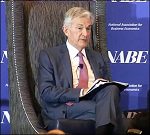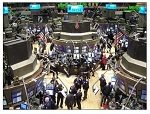-
Recent Posts
- Trump’s “Big Beautiful Bill” Is a Grotesque Giveaway to Fossil Fuel Billionaires While Adding $3.3 Trillion to Nation’s Debt
- Senator Chris Murphy Charges that Trump “Has Opened a Channel for Bribery”
- Congressman Casten: Trump’s Assault on the Rule of Law Is Causing Capital Flight Out of U.S. by Foreign Investors
- Trump’s Approval Rating Drops to 80-Year Low; IMF Says U.S. Tariffs Now Exceed the Highs During the Great Depression
- Nasdaq Has Lost More than 3,000 Points Since Trump’s First Full Day in Office in 2025; the Pain Has Barely Begun
- The Bond Crisis Last Week Was a Global No-Confidence Vote in U. S. President Donald Trump
- Trump’s Tariff Plan Guts $5 Trillion in Stock Value in Two Days; Senator Warren Calls for Emergency Action Before Markets Open on Monday
- Trump’s Attacks on Big Law, Universities, and the Media Have a Common Goal: Silence Dissent Against Authoritarian Rule
- Trump Administration Gives All Clear to Laundering Money through Shell Companies and Bribing Foreign Officials
- Four Megabanks on Wall Street Hold $3.2 Trillion in Uninsured Deposits – Which May Explain Senator Schumer’s Pivot to the GOP to Stop a Government Shutdown
- Here’s What Came Crashing Down Yesterday for Trump’s “Genius” Guy, Elon Musk: Tesla Stock, Access to Twitter (X), His Years of Secret Calls with Putin
- After Banning the Associated Press, Trump Is Now Targeting Specific Journalists That He Wants to See Fired
- Closely Watched Atlanta Fed Model Predicts Negative U.S. Growth in First Quarter
- Trump’s Gangster Diplomacy Makes Front Page Headlines Around the Globe
- Who Benefits Alongside Elon Musk If He Succeeds in Killing the CFPB: the Megabanks on Wall Street that Underwrite His Tesla Stock Offerings
- In Trump 1.0, the State Department Used Taxpayer Money to Publish a Book Elevating Elon Musk to a Superhero; It Was Funded by USAID, the Agency Musk Wants to Quickly Shut Down
- News Host Joy Reid Raises Threat of Trump Selling U.S. to Putin; Ten Days Later Her Show Is Cancelled
- Elon Musk’s DOGE Appears to Be Violating a Court Order; It Has Taken Down Hundreds of YouTube Videos that Educate Americans on How to Avoid Being Swindled
- Barron’s Releases Audio of Jamie Dimon Cursing Out His Workers at a Town Hall, as Dimon Plans to Dump Another One Million JPM Shares
- There’s One Federal Investigative Agency that Neither Trump nor Elon Musk Can Touch: It Just Opened an Investigation into DOGE
- Elon Musk’s Companies Were Under Investigation by Five Inspectors General When the Trump Administration Fired Them and Made Musk the Investigator
- Donald Trump Gives the Greenlight to Goldman Sachs and JPMorgan Chase to Return to Bribing Foreign Officials
- After Tech Geeks Built a Back Door to Loot Billions from FTX, Republicans Refuse to Investigate What Elon Musk’s Tech-Squad Did Inside the U.S. Treasury’s Payment System
- Former Prosecutor, Now U.S. Senator, Informs Tesla That CEO Musk May Be Violating Federal Law and to “Preserve All Records”
- Trump’s Hedge Fund Guy Is Now Overseeing the U.S. Treasury, IRS, OCC, U.S. Mint, FinCEN, F-SOC, and the Consumer Financial Protection Bureau
- As Elon Musk Begins Shutting Down Payments to Federal Contractors, a Strange Money Trail Emerges to His Operatives Inside the U.S. Treasury’s Payment System
- JPMorgan Chase Charged by Yet Another Internal Whistleblower with Cooking the Books
- We Asked Google’s AI Search Model, Gemini, Questions About the Fed and Wall Street Megabanks: It Got the Answers Dead Wrong
- With Trump and Melania’s Crypto Coins Likely to Raise Legal Challenges, Why Didn’t Trump Fire the SEC’s Inspector General in His Purge of IGs?
- Fossil Fuel Industry Could End Up Paying Tens of Billions for LA Wildfires and Deceiving the Public on Climate Change for Decades
- It’s Being Called the Biggest Grift by a President in U.S. History: Trump and First Lady Launch their Own Crypto Coins
- Trump Plans to Install a Fracking CEO to Head the Energy Department and Declare a National Emergency on Energy to Gain Vast Powers
- Fossil Fuel Money Played a Role in the Los Angeles Fires and the Push to Install Pete Hegseth as Secretary of Defense
- When It Comes to Wealth Retention in Retirement, Concrete May Be the New Gold
- Wall Street Watchdog Warns “Clock Is Ticking on a Coming Catastrophic Financial Crash”
- Wall Street Is Sending the Same Message to Americans on Fossil Fuel Financing that It Sent on Cigarettes: Drop Dead
- In a Six-Week Span, this Dark Pool with a Curious Past Traded 3.7 Billion Shares
- Wall Street’s Lobby Firm Hired Eugene Scalia of Gibson Dunn to Sue the Fed for Jamie Dimon
- Postmaster General Louis DeJoy Made $561,051 in Compensation in 2024, as Mail Costs Spiked and Delivery Deteriorated
- Fed Chair Jay Powell Sends a Bold Message to Trump and Tanks the Dow by 1123 Points
- The Head of Fixed Income at T. Rowe Price Makes the Scary Case for the 10-Year Treasury to Spike to 6 Percent
- $663 Billion in Cash Assets Have Gone Poof at the Largest U.S. Banks
- Donald Trump to Ring Bell at New York Stock Exchange Today as Hit List Posters Appear in Manhattan Targeting Wall Street CEOs
- Trump Has a Slush Fund to Prop Up the Dollar – Will He Use It to Prop Up Bitcoin Instead?
- A CEO Assassination; a Billionaire Heiress/NYPD Commissioner; a Secret Wall Street Spy Center – Here’s How They’re Connected
- Despite More than 1600 Tech Scientists Signing a Letter Calling Crypto a Sham, Trump Names a Crypto Cheerleader for SEC Chair
- The Fed Rings a Warning Bell: Hedge Funds and Life Insurers Are Reporting Historic Leverage
- Trump’s Nominee for FBI Director, Kash Patel, Has Businesses Financially Intertwined with Trump
- Donald Trump Is at Risk of Getting Named in a Fossil Fuels Conspiracy Lawsuit
- Trump Is Having Difficulty Getting a Lawyer to Accept the Nomination for SEC Chair: Here’s Why
Search Results for: Federal Reserve
Fed’s Powell Admits a Bigger Bailout for Wall Street Is Coming; Fed’s Balance Sheet Ballooned by $176 Billion Since September

By Pam Martens and Russ Martens: October 9, 2019 ~ Yesterday, at a speaking event in Denver at the National Association of Business Economists, Federal Reserve Chairman Jerome Powell acknowledged that a larger, long-term bailout of Wall Street is coming. His two key points were buried in a subterfuge of puffery but came across loud and clear: “…my colleagues and I will soon announce measures to add to the supply of reserves over time.” And this: “As we indicated in our March statement on balance sheet normalization, at some point, we will begin increasing our securities holdings to maintain an appropriate level of reserves. That time is now upon us.” Let that final statement sink in for a moment. Under the previous Federal Reserve Chair, Janet Yellen, balance sheet normalization at the Federal Reserve meant reducing the Fed’s unprecedented $4.5 trillion balance sheet to get back to something near pre-crisis levels. … Continue reading
Connecting the Dots to the Budding Wall Street Crisis

By Pam Martens and Russ Martens: October 8, 2019 ~ We’re going to do today what mainstream media has failed to do for the American people so far this year — as well as prior to the onset of the 2008 financial collapse on Wall Street. We’re going to connect the dots that strongly suggest that both the U.S. and global financial system have a real problem occurring right under the fogged lenses of Congress. Dot 1 — Freezing Customers Out of their Mutual Fund. Let’s start with our reporting on July 11 of this year, titled Is There a Stealth Financial Crisis? Alarm Bells Are Ringing. In that article we pointed out that one of Britain’s high profile money managers, Neil Woodford, had frozen customer withdrawals from his flagship $4.7 billion Woodford Equity Income Fund. The latest news is that the fund is not expected to reopen until at … Continue reading
Fed Says It Will Offer $310 Billion More in Term Loans to Wall Street as Over 68,000 Job Cuts Planned at Mega Banks

By Pam Martens and Russ Martens: October 7, 2019 ~ One or more U.S. or foreign banks that are primary dealers to the Federal Reserve Bank of New York is in need of longer-term loans that they are unable to get anywhere else – at least at an affordable rate of interest. That’s the only reasonable conclusion that can be drawn from the Fed’s announcement on Friday that it is extending its money pumping program to Wall Street until at least November 4 and will be offering an additional $310 billion cumulatively in term loans (most for 14-days at a time) as well as offering at least $75 billion daily in overnight loans. The Fed’s money sluicing operation that began abruptly on September 17 is taking on the distinct appearance of its machinations during the early days of the 2008 crash – a time when it also refused to name … Continue reading
There’s Nothing Normal About the Fed Pumping Hundreds of Billions Weekly to Unnamed Banks on Wall Street: “Somebody’s Got a Problem”

By Pam Martens and Russ Martens: October 4, 2019 ~ Yesterday, the House Financial Services Committee released its hearing schedule for October. There is not a peep about holding a hearing on the unprecedented hundreds of billions of dollars that the Federal Reserve Bank of New York is pumping into unnamed banks on Wall Street at a time when there is no public acknowledgement of any kind of financial crisis taking place. Congressional committees should have been instantly on top of the Fed’s actions when they first started on September 17 because the Fed had gone completely rogue from 2007 to 2010 in funneling an unfathomable $29 trillion in revolving loans to Wall Street and global banks without authority or even awareness from Congress. The Fed also fought a multi-year court battle with the media in an effort to keep its giant money funnel a secret. According to Section 1101 … Continue reading
Derivative Risks Rising: Sell-Off in Interconnected Mega Banks and Insurers

By Pam Martens and Russ Martens: October 3, 2019 ~ The Dow Jones Industrial Average has lost 838 points in the past two days of trading. On a percentage basis, its losses pale in comparison to the losses experienced over the past two days by some of the biggest global banks as well as insurance companies that are derivative counterparties to the big banks. Mega banks continue to be allowed to tie their risky trading gambles to the balance sheets of insurers that also hold life insurance policies and retirement annuities for Moms and Pops across the U.S. by using the insurers as counterparties for their derivative trades. That this is still happening illustrates just how little has changed in the way of enlightened regulation of Wall Street since the banks brought down the big insurer, AIG, in 2008. The U.S. government was forced to seize AIG and institute a … Continue reading
JPMorgan Chase Has a Pattern of Criminality; Now Wall Street Is Pointing to the Bank as a Cause of the Fed’s Emergency Loans

By Pam Martens and Russ Martens: October 2, 2019 ~ Two notable things happened on Monday, September 16, 2019. Rates started to spike in the overnight loan (repo) market, reaching a high of 10 percent the next day and forcing the Federal Reserve to step in as a lender of last resort for the first time since the financial crisis. The Fed has had to intervene every business day since then with overnight loans, funneling hundreds of billions of dollars to its primary dealers, while also providing $150 billion in 14-day term loans to unnamed banks. The other notable thing to occur on September 16 was this: The largest bank in the United States, JPMorgan Chase, had its precious metals desk charged by the U.S. Department of Justice with being a criminal enterprise for approximately eight years as it rigged the prices of gold, silver and other precious metals. The … Continue reading
Tom Mueller’s New Book Shows How Whistleblowers Are Increasingly Left to Do the Job that Law Enforcement Won’t

By Pam Martens and Russ Martens: October 1, 2019 ~ Tom Mueller’s new book, Crisis of Conscience: Whistleblowing in an Age of Fraud is being released today by Riverhead Books, an imprint of Penguin Random House. It’s packed with seven years of research and inspiring personal interviews. Despite its initially intimidating 600-page heft, it’s an enticing read as it connects the dots to how a country like the United States, founded on the premise of “equal justice under law,” as engraved on the front of the U.S. Supreme Court, has become a “banana republic” with only whistleblowers’ pockets stuffed with crinkled documents or secret tape recordings all that stand between resuscitating our democracy or a complete collapse into oligarchy. Mueller builds an incontrovertible case that the United States has become a dystopian society where almost every government entity that a citizen would typically turn to for redress over a lawless … Continue reading
The Repo Loan Crisis, Dead Bankers, and Deutsche Bank: Timeline of Events

By Pam Martens and Russ Martens: September 30, 2019 ~ Last week, as the Fed was carrying out hundreds of billions of dollars in emergency loan operations on Wall Street for the second week in a row – the first such operations since the financial crisis – Deutsche Bank’s headquarters office in Frankfurt, Germany was being raided by police for the second time in less than a year. That’s not the sort of thing that inspires confidence among depositors to keep their money in your bank. Deutsche Bank has been a constant headache for the U.S. financial system because it is heavily intertwined via derivatives with the big banks on Wall Street, including JPMorgan Chase, Citigroup, Goldman Sachs, Morgan Stanley and Bank of America. It has become the dark cloud on the horizon in the same way Citigroup cast a negative pall in the early days of the financial crisis … Continue reading
The Fed Is Offering $100 Billion a Day in Emergency Loans to Unnamed Banks and Congress Is Not Curious Enough to Hold a Hearing

By Pam Martens and Russ Martens: September 27, 2019 ~ The Federal Reserve Bank of New York first initiated its emergency overnight loans to Wall Street this year on Tuesday, September 17, starting off at the rate of $75 billion daily. It then increased its loans by adding, in addition to the $75 billion daily, 14-day term loans in the amount of $30 billion to be offered three times this past week. But after the demand for the first 14-day loan was more than double the $30 billion offered, the New York Fed boosted the next term loans to $60 billion and increased its overnight loans to $100 billion. What will next week bring? When Wall Street can get super cheap loans from the Fed in the tens of billions of dollars with no questions asked by Congress, it will continue upping its demands until the Fed is once again … Continue reading
Wall Street Bank Stocks Closed in a Sea of Red Yesterday as Fed Pumps in Another $105 Billion of Liquidity

By Pam Martens and Russ Martens: September 25, 2019 ~ It was only a matter of time until the public perception of the Federal Reserve having to funnel billions of dollars a day to Wall Street banks as an emergency source of liquidity started to impact the share prices of those same banks. It all caught up with the mega banks yesterday as every single one of their stocks closed in the red. Notably, the German bank, Deutsche Bank, that is heavily interconnected to the behemoths of Wall Street through derivatives, lost the most ground yesterday, closing down 2.70 percent at $7.58 – just $1.14 above its all-time low of $6.44 that it set on August 15. The U.S. banks that were named as being heavily interconnected to Deutsche Bank via derivatives in a 2016 report from the International Monetary Fund (IMF) closed as follows yesterday: Goldman Sachs lost 2.67 percent; … Continue reading

